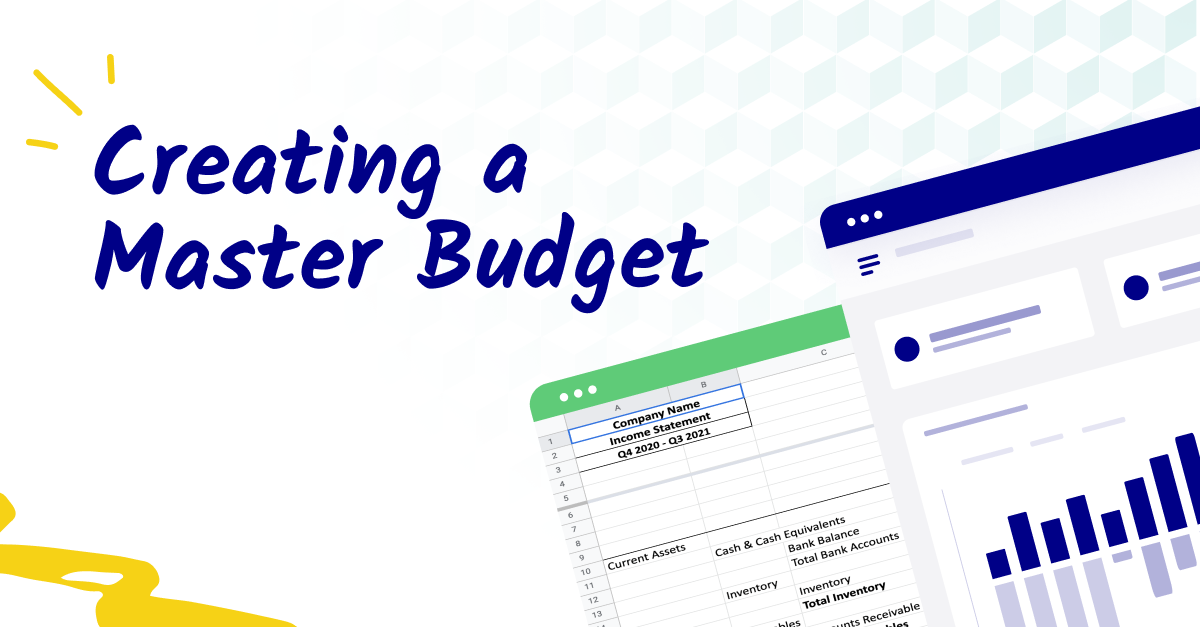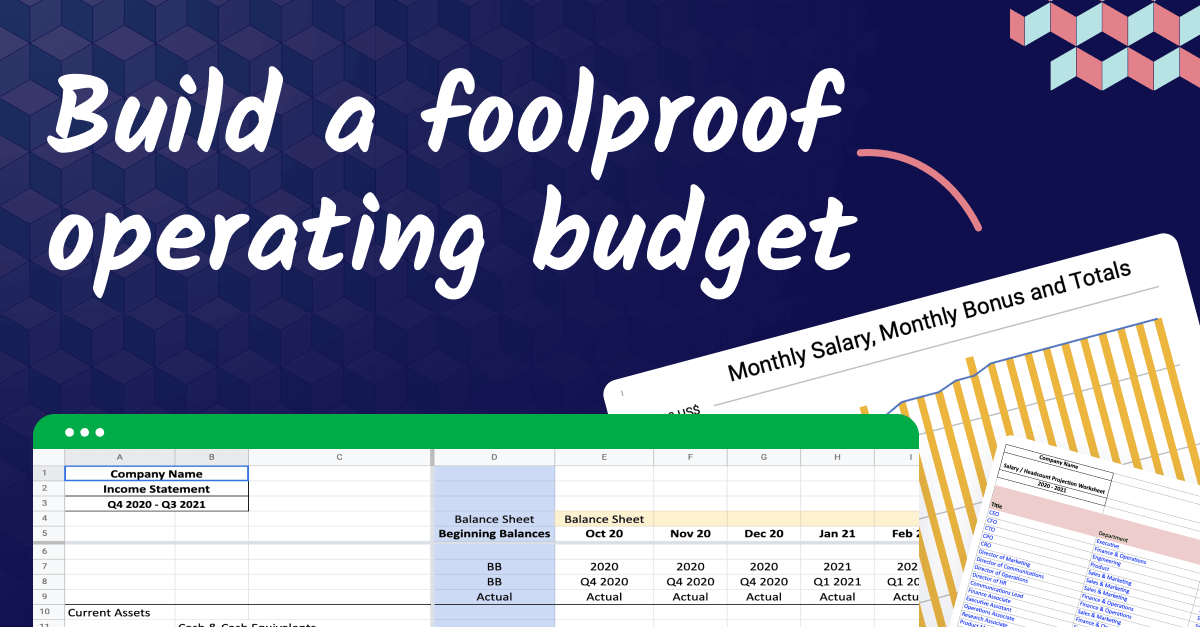What is the purpose of a master budget?
A master budget is a comprehensive financial plan that's created by combining all individual department and business unit budgets into a single, unified document.
This gives business leaders a holistic view of their organization's finances, allowing them to make more informed—and accurate—decisions about their organization’s overall performance.
The master budget is typically prepared for a specific period, often annually, and it outlines the company's operations for that period.
Master budgets typically contains two broad categories of budgets: the operating budget and the financial budget.
The operating budget includes budgets that make up the income statement, showing the company's operational performance.
Examples of such operating budgets are sales budgets, production budgets, direct labor budget, administrative, etc. Each of these budgets reflects the revenue and expenses that primarily involve the operational activities of the business.
The financial budget includes budgets that result in the projected balance sheet. The financial budget includes elements like the cash budget, budgeted balance sheet, etc.
Elements of a master budget
Let's review some of the budgets that make up the master budget in greater detail:
Sales budget
A sales budget contains projections and estimates of future sales. The sales budget typically includes details about product line sales, sales volume, pricing, discounts, and promotion costs.
The sales figures within a sales budget directly inform revenue projections and give context for how other components of the master budget are affected. For example, if there’s a large dip in projected revenue, the business may need to adjust its cash flow statement.
Wage and direct labor budget
Wage and labor budgeting in a master budget plans for expenses associated with hiring and retaining talent. This budget component allocates funds for employee compensation, enabling cash flow forecasting and better financial management.
The wage section covers more than just cash spent on salary. It includes:
- Employee wages
- Bonuses
- Overtime
- Paid leave
- Workers’ compensation insurance premiums
- Healthcare
These components all factor into the estimate of what a business will spend on its workers. By managing this segment of the budget effectively, businesses ensure they have enough money allocated to fairly compensate their workers while still turning a profit within the master budget.
Production budget
A production budget (sometimes called a direct material purchases budget or a cost of goods sold budget) specifies the expected output for producing goods and materials such as machinery costs, material purchases, and operational expenses.
These projections allow the business to anticipate production-related expenses and prepare for different scenarios. This future-looking approach to manufacturing results in better resource allocation and higher profitability within the mater budget.
Administrative budget
The administrative, or overhead, budget tracks overhead expenses like rent, utilities, taxes, and insurance necessary for day-to-day operations. An accurate estimate is important to ensure that enough funds are allocated for these investments, as well as for unforeseen challenges when creating a master budget.
Cash budget
A cash budget is a record of expected cash inflows and outflows over the upcoming budget period. A cash budget helps ensure a business has enough funds to cover short-term needs, like payroll, taxes, and inventory costs, and shows the organization's financial health.
Budgeted financials
Another element of the master budget are the budgeted financial statements (including a budgeted balance sheet) provide a summary of expected financial performance, including revenue, expenses, and cash flow.
This helps the business manage and budget for upcoming activities and provides context for future finances, resource allocation, and priorities.
Bringing together the insights and data from these various business units results in a comprehensive document that drives organizational progress.
With these components laid out in detail, business leaders can analyze costs and profits more effectively.

The top four benefits of an effective master budget
A master budget provides a 360° view of a business, allowing leaders to adjust individual departments, projects, or spending categories. It incorporates visibility and flexibility into the overall strategy.
But those aren't the only benefits it offers. A master budgets provides many critical advantages, including:
1. Visibility
A master budget provides a clear, comprehensive view of an organization's financial plans, giving managers visibility into every aspect of the organization's planned operations and financial activities.
The visibility provided by the master budget enables them to better understand how resources are allocated, where the company expects to earn revenue, and where expenses will be incurred.
Furthermore, this visibility helps identify potential financial issues before they become problematic, enabling preventive measures.
2. Opportunity
By giving a comprehensive view of the financial plan, a master budget can reveal opportunities for more efficient use of resources.
For instance, the master budget might highlight areas where costs can be reduced or reveal potential avenues for increasing revenue. These opportunities might not be readily apparent without the detailed planning and analysis involved in creating a master budget.
3. Communication
The process of creating a master budget often involves input and collaboration from multiple departments and managers. This collaborative process helps facilitate communication and coordination across the organization.
Each department can understand how their individual budgets and objectives align with the organization's overall goals as documented within the master budget. This can foster a sense of shared purpose and cohesion within the organization.
4. Completeness
A master budget includes all of the various individual budgets within an organization, providing a complete picture of the organization's financial plan.
This comprehensiveness allows managers to see how all of the different parts of the organization's financial plan fit together. It also ensures that all financial aspects of the organization's operations are considered and that no important elements are overlooked. A master budget brings a level of cohesion to an organization's financials.
Establishing a collaborative budgeting framework
Building a master budget is a team sport. That's why a strong framework begins with engaging key decision makers and stakeholders.
This may include explaining basic concepts about budgeting and finance, such as income statements, balance sheets, and a cash flow statement. It also involves outlining the different roles each department or individual has in the master budgeting process.
It's important to set clear expectations for the budgeting process—from establishing a timeline for development, to defining the processes for review and approval.
This ensures all departments are working together to align the master budget with the company’s overall strategy. It also creates transparency in the process.
Key stakeholders to involve in the master budget process
Building a master budget requires effort and insight from multiple levels of the organization, including:
- Department leaders
- Project Managers
- Operations leaders (IT, Security, Legal)
- Accounting Manager
- Budget Analysts
- Executive Team
- Chief Financial Officer (CFO)
Depending on your budgeting approach—top-down or bottoms-up—these important stakeholders will come in at different parts of the master budget timeline.
Top-down versus bottoms-up budgets
Depending on the budgeting approach your company uses, the flow of communication around allocations could vary.
In a top-down budget approach, the the budget is created by senior management and then passed down to the lower levels for execution.
In this scenario, upper-level stakeholders come in early in the budgeting process, setting the high-level budget goals and objectives, while lower-level managers are involved later, usually in the execution phase.
In a bottoms-up scenario, lower-level employees or managers create their departmental budgets, which are then consolidated and approved by higher management. Sales works on the sales budget, operations works on the administration budget, and so on.
In this case, the lower-level stakeholders are involved from the beginning, while upper-level management comes in at the end to review and approve the budget.
Best practices for effective collaboration in master budgeting
A connected and flexible budget makes it easier to hit your numbers, maintain a positive business culture, and create an accurate master budget. These best practices can help you foster a streamlined and collaborative approach to budgeting within your organization.
1. Review historical data
Past budgets tell a vivid story about performance versus expectation, which makes them the perfect place to start when building a new master budget.
Looking back at past budget cycles can help you gain insight into how and why certain decisions were made, and what the outcome was. They shine a light on inefficient spending or resource allocation, providing insight for future improvement.
2. Engage with operational leaders
Engaging department leaders is an important step in a successful budgeting process. These boots-on-the-ground stakeholders lend their expertise when it comes to the operational needs of the department and how best to meet them.
Involving operational leaders also keeps them in the loop on larger organizational objectives, which helps them support those goals. By involving department heads early and often, organizations create a culture of investment and mutual support. The master budget should be prioritized and engaging with leaders across the company makes that more possible.
3. Conduct regular meetings
Creating a master budget is a complex task that involves multiple departments, each with its own unique perspective and insights. Regular meetings and workshops provide a platform where these diverse perspectives can come together.
Each department can discuss its budgeting needs, strategic initiatives, potential challenges, and constraints. This mutual understanding allows the creation of a budget that's grounded in the realities of each department's operations, leading to a more accurate and realistic master budget.
These sessions also foster a sense of collective ownership over the master budget. When each department has an opportunity to contribute to the budgeting process, they are more likely to feel invested in the outcomes.
4. Encourage transparency
Budgeting and roadmapping may bring out strong opinions about the path the company takes or the most likely activities to produce results. As part of transparency efforts, encourage a culture of communication among and through the org chart.
Provide channels and points of contact for individual contributors to discuss proposed or upcoming change. Use data forms or surveys as a way to collect information, hear alternate perspectives, and identify unforeseen outcomes before a master budget activity is put into practice.
5. Use technology to facilitate communication
Technology makes it easier than ever to share ideas and centralize research for budgeting. Use messaging platforms such as Slack or Microsoft Teams for quick feedback and centralized communication in budgeting.
You may also want to consider FP&A software, which creates a single source of truth for all budgeting data, historical budgets, tracking, and measurement. This type of software improves collaboration by providing an efficient way to share information and work together on projects. If you're looking to create an up-to-date, flexible budget, getting help from a software solution might be a good investment for your team.
Incorporating feedback for continuous improvement
When it comes to budgeting, feedback provides insight to guide continuous improvement. It allows leaders to adjust goals and shift allocations based on changing needs to create a living, breathing master budget.
Feedback loops, such as periodic check-ins and automated reporting, allow teams to keep fresh eyes on the budget and take corrective action quickly when needed.
This continual evaluation of budgets in relation to shifting business needs creates an environment where feedback and collaboration is encouraged, and teams can work together to generate better ideas.
The master budget revision process also provides a repeatable method of assessing and responding to change, ensuring your team constantly learns from past experiences and incorporates those new findings into their work.
Monitoring and adjusting the master budget
Budget activities have quantifiable results and offer many insights—but to harness them, you need to know what you’re looking for.
You must also create a framework to track performance over time. Establishing a set of key performance indicators (KPIs) to evaluate your master budget performance is the most important step of implementation.
Answer these questions to learn more about your monitoring and tracking needs:
What should I look for?
With the right set of metrics, you’ll have a direct view of what matters most. Align your metrics to the strategic priorities set earlier in the budgeting process.
For instance, if the organization is looking to build its efficiency, tracking metrics such as net dollar retention or burn multiple may give you the best view of progress within your master budget.
How often should I review?
The size, stage, and complexity of your business will determine the cadence for reviewing your budgeting process.
Some companies with simpler structures may choose to review budgeting monthly. More established or larger companies may stretch this out to a quarterly or annual review.
Small businesses with less flexibility and cash reserves often benefit from more stringent review to avoid small problems multiplying or going unnoticed.
What should I do about variances?
Variance analysis is key to understanding the success of the master budget. It also reveals strengths and challenges in the budget process itself.
Perform variance or flux analysis as often as needed to catch budget issues before they flourish. Remember that even favorable variances should get some attention to ensure you’re maximizing resource use and growth potential.
How do I integrate the information?
There are multiple ways to integrate findings from the budget process into your financial practice:
-
Corrective action is the biggest upside of the master budgeting process. Once inefficiencies or issues come to light, the budget team and stakeholders have data and context to change the process and improve accuracy.
-
Issues and variances are indicators that something within your master budget—be it a calculation, spend level, or earnings assumption—is missing the mark. Dig into the needs and assumptions to find the misalignment and correct it to improve future reporting.
-
Review your master budget against actuals. Be sure the provisions you set out in previous budgets meet expectations. If not, review the assumptions that got you there. For example, dig into the sales budget and look for areas where sales figures were overambitious, production experienced challenges, etc. Also look at large scale economic change that might have skewed expected results.
Aligning the master budget with strategic objectives
For a master budget to be truly effective, it must align closely to the company’s goals and priorities. To do this, all stakeholders must first agree on what those goals are.
Collaborate with executive leadership to define master budget priorities. Regardless of your overall budget approach, it’s important to understand where leadership sees the business going over the following budget period.
Are they focused on product development, growth, market strategy? Whatever the big picture holds, the allocations within the departmental and master budgets must support those endeavors.
Link departmental budgets to the overall strategic direction. Once strategic priorities are established, each department must develop a budget that supports those goals (think back to our budget types above, sales budget, administrative budget, wage budget, labor budget, etc).
To do this, teams must define the resources (capital, materials, and talent) necessary to take on new initiatives and support current programs.
Evaluate each budget proposal on its strategic contribution. Every proposal the evaluation team adopts must aid in moving the company toward its goals.
View a proposal through the lens of its cost and its alignment with wider goals. Budgets should maximize opportunities for operational improvement while maintaining baseline profitability.
Effective budget review and approval process
Collaboration is key to success in budget approvals. Involving stakeholders from all departments in the process provides insight on potential trade-offs, risks, and considerations of each potential project.
Use these strategies to boost collaboration in proposal approvals:
1. Use a template to streamline the process
Creating a template for budget proposals allows reviewers to perform an apples-to-apples comparison on the merits, challenges, costs, and potential returns of a proposal. It puts all elements of the proposals in clear and similar terms.
2. Be sure the review process is interactive
Schedule regular stakeholder meetings to review and discuss budget proposals and align them with broader objectives.
Encourage curiosity in the process. Allow stakeholders to ask questions and provide feedback on budget proposals to identify potential areas of improvement or more efficient solutions.
3. Centralize current and historical budget data
Create universal access to resources as a point of reference when discussing proposed changes in capital expenditures or new initiatives.
4. Get your champions involved early
Invite the executive team to be an active participant in budget proposals. Bring clear data to share the story of how projects will benefit the organization and align to the larger needs of the business.
5. Leave room for discussion
With many perspectives on the budget process come potential differences in opinion. Create space for stakeholders to air concerns, discuss potential downsides, present trade-offs, and collectively establish priorities for the business. These conversations often present new information to guide decision-making.
6. Strive for transparency
Although leaders make budget decisions, the outcomes of the proposal process have far-reaching implications. Be sure to communicate the rationale for decisions in clear and concise language.
If proposals don’t align with priorities, provide feedback and discuss ways in which to achieve proposal goals in the future.
7. Make technology your ally
Use data-driven tools such as financial reporting software to inform decisions about budget proposals, ensuring accuracy and transparency in the process.
Conclusion: teamwork makes the dream work
Remember, the strength of a master budget lies in its ability to unite a team towards shared financial objectives. So, start incorporating these best practices today to create a master budget that truly drives your organization forward.
Want to make it easier for your team to collaborate on budgeting processes? Request a free demo today to learn how Cube can help make your team more efficient.



.png)









.png)





.png)
.webp)